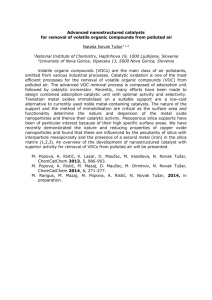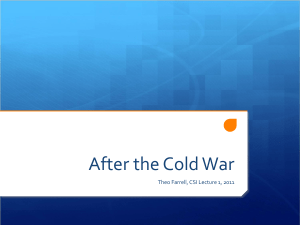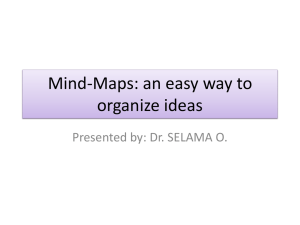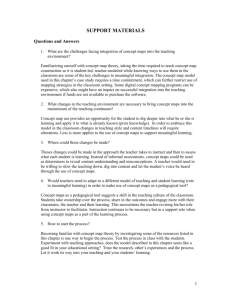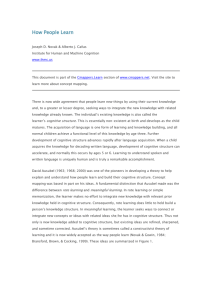Concept maps, mind maps and other similar graphic representation
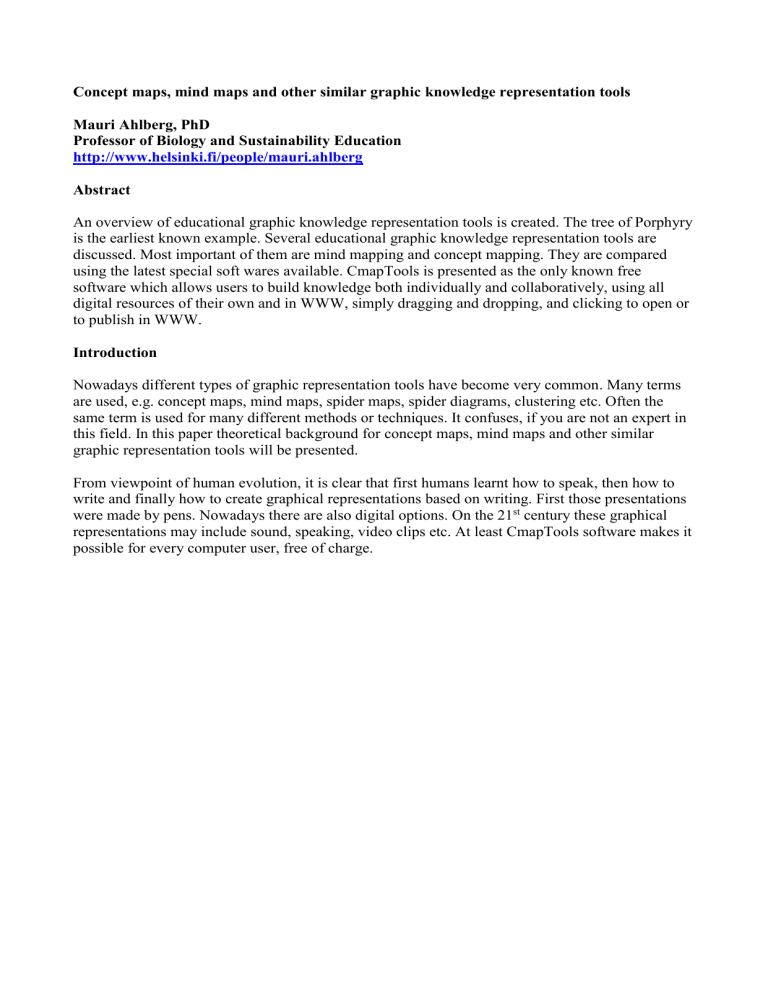
Concept maps, mind maps and other similar graphic knowledge representation tools
Mauri Ahlberg, PhD
Professor of Biology and Sustainability Education http://www.helsinki.fi/people/mauri.ahlberg
Abstract
An overview of educational graphic knowledge representation tools is created. The tree of Porphyry is the earliest known example. Several educational graphic knowledge representation tools are discussed. Most important of them are mind mapping and concept mapping. They are compared using the latest special soft wares available. CmapTools is presented as the only known free software which allows users to build knowledge both individually and collaboratively, using all digital resources of their own and in WWW, simply dragging and dropping, and clicking to open or to publish in WWW.
Introduction
Nowadays different types of graphic representation tools have become very common. Many terms are used, e.g. concept maps, mind maps, spider maps, spider diagrams, clustering etc. Often the same term is used for many different methods or techniques. It confuses, if you are not an expert in this field. In this paper theoretical background for concept maps, mind maps and other similar graphic representation tools will be presented.
From viewpoint of human evolution, it is clear that first humans learnt how to speak, then how to write and finally how to create graphical representations based on writing. First those presentations were made by pens. Nowadays there are also digital options. On the 21 st century these graphical representations may include sound, speaking, video clips etc. At least CmapTools software makes it possible for every computer user, free of charge.
History of graphic presentation tools of concepts and propositions
The first known graphical presentation of concepts and their relationships is the tree of Porphyry, also known as arbor porphyriana or Porphyrian tree (Fig.1). It is from probably from the third century, because according to Emilsson (2005), Porhyry lived 234?–305? A.D.
substance
material immaterial spirit
bodies
animate inamate rock
organisms
sensitive insensitive plant
animals
rational irrational
humans
non-human animals
Aristotle
Socrates other human beings
Fig. 1. The Tree of Porphyry (redrawn and adapted from Reese 1980, Niiniluoto 1984 and Mason
2004).
Main options of educational graphic knowledge representation methods in the 21 st century
We have not enough space to follow the history of educational graphic knowledge representation methods since the Tree of Porphyry. In main lines it has covered in Stewart (1976) linguistically, and Åhlberg (1990) from viewpoint of educational research. A tentative list of the most common educational graphic knowledge representation methods in the 21st century is as follows: mind maps, concept maps, “spider diagrams”, knowledge maps, clustering. There is a chaos in this field. I try to bring knowledge of the origins of main methods or techniques as far as it is possible in the short space allowed. A useful general practical comparative study is Haller (2002), although unfortunately only in German. Haller (2002) does not mention e.g. Rico (1983 and 2000) who is important inventor of Writing the Natural Way, Cluster™. According to Rico (2007) clustering is non-linear brainstorming process that makes interior, invisible associations visible on a page. Many people misleadingly call Rico’s registered clustering as mind mapping or concept mapping.
Knowledge mapping was created in the research group of Dansereau in 1970s (Dansereau & al. l979, Dansereau 1985, Gardner, Monaghan & Peel 1996, Lambiotte, Dansereau, Cross &
Reynolds 1989). In the 1970’s it was however called network map (Dansereau & al. 1979, 11). It is related to concept maps, but it has rigidly labelled links (e.g. Bahr & Dansereau 2004).
Nowadays, spider maps (spider diagrams) are very popular in UK. The same term is used for many different types of graphic knowledge representation techniques. Forgotten seems to be the history of this term in educational research. The earliest example is probably Hanf (1971, 228) who himself uses only term ‘mapping’. Jones & al. (1989) named her technique as spider mapping, but they do not refer to Hanf (1971). They present the idea of spider map as their own. The same unethical and unprofessional behaviour is still very common among educationalists.
Mind mapping
Mind mapping was invented by Tony Buzan who in 1974 published the first book of this theme. In
Buzan (1974) he used term ‘key words’. The idea was organise the key words into a radiant structure that looks like a tree seen from above. Buzan (1974) used many colours and pictures in his mind maps. In 1990 century Buzan Organisation Limited registered his type of mind maps as Mind
Map®. There is very little research on mind maps, although it is very popular. One of the few research reports of it is written by Farrand, Hussain and Hennessy (2002). They found that mind mapping helps little, but significantly factual recall, memory. Promoting recall or memory of facts is one of the main points of Buzan from the 1970s. The latest published book of Mind Map® is
Buzan and Buzan (2006). The key words for the book are the same as earlier: radiant thinking, brainstorming, personal styles. The dogmatic style of the book is best expressed on page 26: “If you are aware of any (sic!) research, experiments or studies that support (sic!) any (sic!) of the points we make in this book, please do let us know…” The authors are interested only in results that support there views, not those results that are not supporting their views. In science, educational research included, we are in particular interested in those results that do dot support some of our tentative theories Point is that only by continual theoretical and empirical testing we are able to improve our theories and tools.
The web pages of Buzan Center (2007) inform about a new digital tool (iMindmap™) how to create Mind Maps®. Compared to earlier versions of Mind Maps®, the active example presented uses verbs from the core word. This is unique in the world of Mind Maps®. The use of verbs linking concepts is what concept maps are about.
Concept mapping
Concept mapping was developed at Cornell University in 1970s, but the version that spread all over the world was invented in 1980s. Novak and Gowin (1984) made it very popular among science educators. There are false claims who invented, what and when. The timing is claimed to be 1960s or 1970s, and there are other people who claim to be inventors of concept mapping. Åhlberg (1993 and 2004) has studied published documents from the beginning of concept mapping research and he came to conclusions presented above. Novak tried to trademark his version of concept mapping in
1998. The name of his book (Novak 1998) is ‘Learning, creating and using knowledge. Concept
Maps™ as facilitating tools in schools and corporations’. He did not get the trademark, although in the cover page trademark is already announced. There are hundreds of research reports of usefulness and accuracy of concept maps in education (e.g. CMC 2004 and CMC 2006).
The latest introduction and instructions of the Novakian types of concept maps are published as a technical report in the WWW by Novak and Cañas (2006, 1): “Concept maps are graphical tools for organizing and representing knowledge. They include concepts, usually enclosed in circles or boxes of some type, and relationships between concepts indicated by a connecting line linking two
concepts. Words on the line, referred to as linking words or linking phrases, specify the relationship between the two concepts. The result of linking two concepts is a proposition …. Propositions are statements about some object or event …. Propositions contain two or more concepts connected using linking words or phrases to form a meaningful statement.“ They do not say it clearly, but is very important to use a verb phrase, in order to create claim about the real or imagined world. These claims are propositions.
For Novak and Cañas (2006, 1): “Another characteristic of concept maps is that the concepts are represented in a hierarchical fashion with the most inclusive, most general concepts at the top of the map and the more specific, less general concepts arranged hierarchically below. The hierarchical structure for a particular domain of knowledge also depends on the context in which that knowledge is being applied or considered.” The idea of importance of hierarchical knowledge originates from
Novak’s firm belief onAusubel’s (1963) theory of meaningful learning.
I regard my improved version of concept mapping (Åhlberg 1993 and 2004) as general as language itself. Everything that humans are able to express by speaking, can be written. Everything that can be written can be transformed into concept maps. If these concept maps are good enough, the can be transformed accurately back to ordinary texts (writing) and/or speaking. Any learning theory is compatible with improved concept mapping, because it is as general as language itself. Actually improved concept mapping can be used from individual knowledge building/construction to social knowledge building/construction from teams to humankind. Internet finally allows all humankind to learn. It connects al nations, and most key persons. CmapTools is software to create and share concept maps, and for collaborative knowledge building by published concept maps as web pages.
For sure hierarchies are often the most natural way of presenting human knowledge. On the other hand, according to modern science, the World is a system. This idea can be tested even by a thought experiment: Everything in the universe is in some way connected to everything else. If it would not be connected, then humankind would have no chances to get any knowledge of it.
Accordingly it is not part of our universe. This means that only connecting concepts (or key words) is not very interesting, because in the university everything is somehow connected. The point is how concepts are linked to each other in our thinking. Improved concept mapping is an accurate tool to reveal this.
Elements of an improved method of concept mapping
Below I present only five of ten of the ten points how improved concept maps differ from original
Novakian concept maps (for the full list see Åhlberg 2004):
1) All concepts are interpreted as main elements of thinking and learning, and they are always inside frames. In Novak and Gowin (1984, pp.14, 22, 52) and Novak (1998, p. 100) concepts are sometimes inside frames and sometimes not.
2) Novak and Gowin (1984) and Novak (1998) prefer very short verbal labels for concepts.
However, concepts sometimes require many words in order to be correctly labelled. There is no accurate limit on how many words may be included in a concept label. In an improved concept map as many words as are needed are used to name the concept accurately.
3) In order to have a meaningful proposition, all links between concepts have arrowheads to show in which direction the connection from one concept to another is to be read. However, if they were following their own rule, in Novak and Gowin (1984) and Novak (1998), only the concepts that are either horizontal or are to be read upwards should have an arrowhead. Thus, this complex rule is not always remembered even by those who use the traditional Novakian concept mapping (e.g., Novak
& Gowin, 1984, p. 176; Novak, 1998, pp. 52, 84,121). Already Novak and Gowin (1984, p. 102)
presented a concept map in which all links had arrowheads, and they called it “a good concept map.” I agree, it is a better than ordinary concept map.
4) The expressions connected to links may be short or long, but they must accurately express the thinking of the person whose thoughts are concept mapped. Novak and Gowin (1984) and Novak
(1998) favour very short verb expressions. The essential point is that the link includes a verb expression and the resulting proposition is meaningful and more or less true, plausible, probable, et cetera.
5) You may connect pictures, videos, sounds, et cetera to concept maps (e.g., Åhlberg, 1993) Novak and Gowin (1984) and Novak (1998) never do this.
CmapTools as software allowing both individual and collaborative learning and knowledge building
CmapTools is created by Institute of Human and Machine Cognition (USA). It is designed for creation of concept maps. Concept and propositions are main elements of knowledge. They are organised in concept maps. Concept maps are a tool to explicate knowledge for creation of knowledge and knowledge management, and both for individual and collaborative knowledge building (e,g, Novak 1998, Åhlberg 2004). CmapTools can be used to create a multimedia hypertext from concepts, through links to digital resources, like documents, pictures, video clips, computer programs, internet links etc. It is very easy to use. School children have learnt easily to use it.
Digital resources are attached to concepts by intuitive and very simple ‘drag and drop’ operation.
The icon of any digital resource is just dragged and dropped onto the concept, to which it is wanted to be linked. Publishing concept maps in the internet and WWW is extremely easy. There is a button on the left bottom corner. When it is clicked, a new web page is created from the concept map. This is by far the fastest way to create web pages, e.g. homepages. In the folders of any of the
Public CmapTools servers you can create portfolios of your and your students work. These cumulative archives may be commented and continually improved both individually and collaboratively. As far as I know, no other graphic knowledge presentation soft ware has these kinds of properties.
Comparing concept mapping and mind mapping
Next I compare concept mapping and mind mapping. I tried to use the same concepts (Figures 2. and 3.) I used new iMindMap soft ware. It did not allow me to use as long phrases I am used to do while working with CmapTools. that is why I had to shorten and transform certain expressions.
Please, try first to read the Mind map and then the concept map. You probably agree that improved concept mapping is very accurate presentation of the authors thinking. On the other hand, mind mapping is just hinting, not presenting you ideas as accurately.
Figure 2. Mind Map of the theme ‘graphic knowledge presentation tools’. This picture is created by commercial iMindMap™ software.
Figure 3. Concept maps of the theme ‘graphic knowledge presentation tools’. This picture is created by free CmapTools software.
Conlusions
There are many different types of graphical knowledge presentation tools. It is partly matter of the taste what to use. But if you want to monitor and promote your students learning and thinking, then you probably use concept maps and CmapTools. It is free of charge. If a concept map is saved on any public server, everybody may see the concept map, and if the author allows, everybody can comment on it by yellow notes. You may also create a concept map together from different computers. Using CmapTools you and your students will learn both individual and collaborative knowledge building. They are important skills in the emerging global knowledge society.
References
Åhlberg, M. 1993. Concept maps, Vee diagrams and Rhetorical Argumentation (RA) Analysis:
Three educational theory-based tools to facilitate meaningful learning. Paper presented at The Third
International Seminar on Misconceptions in Science and Mathematics. August 1- 5, 1993. Cornell
University. Published digitally in the Proceedings of the Seminar, http://www.mlrg.org/proc3abstracts.html
(Read 30. 1. 2007) The whole paper: http://www.helsinki.fi/sokla/bgee/Ahlberg_Cornell_1993.doc
(Retrieved 30. 1. 2007)
Åhlberg, M. 2004.Varieties of concept mapping. In Canas, A., Novak, J., Gonzales, F. (Eds.)
Concept Maps: Theory, Methodology, Technology. Proceedings of the First International
Conference on Concept mapping. CMC 2004. Pamplona, Spain, Sept 14 – 17, Vol. 2, 25- 28, http://cmc.ihmc.us/papers/cmc2004-206.pdf
Ausubel, David. 1963. The psychology of meaningful verbal learning. New York: Grune &
Stratton.
Bahr, Susanne & Dansereau, Donald. 2004. BILINGUAL KNOWLEDGE (BIK-) MAPS: STUDY
STRATEGY EFFECTS, In Canas, A., Novak, J., Gonzales, F. (Eds.) Concept Maps: Theory,
Methodology, Technology. Proceedings of the First International Conference on Concept mapping.
CMC 2004. Pamplona, Spain, Sept 14 – 17, http://cmc.ihmc.us/papers/cmc2004-100.pdf
Buzan, Tony 1974. Use your head. London: BBC Books.
Buzan, Tony & Buzan, Barry. 2006. The Mind Map® Book. Harlow: BBC Active.
Buzan Center (2007). Buzan world. Tony Buzan's official home page, http://www.buzanworld.com/
CMC 2004. First International Conference on Concept Mapping. Proceedings in the WWW.
Pamplona, Spain Sept. 14-17, 2004, http://cmc.ihmc.us/CMC2004Programa.html
CMC 2006. CMC 2006. Second International Conference on Concept Mapping. Proceedings in the
WWW. San José , Costa Rica Sept. 5-8, 2006, http://cmc.ihmc.us/CMC2006Program.html
Emilsson, Eyjólfur, 2005. "Porphyry", The Stanford Encyclopedia of Philosophy (Spring 2005
Edition), Edward N. Zalta (ed.), URL =
< http://plato.stanford.edu/archives/spr2005/entries/porphyry/ >.
Farrand, Paul, Hussain, Fearzana and Hennessy, Enid. 2002. The efficacy of the ‘mind map’ study technique. Medical Education. 36, 426 – 431.
Gardner, Stephanie, Monaghan, Michael & Peel, Jennifer. 1996. Knowledge Maps Improve
Comprehension in Therapeutics. American Journal of Pharmaceutical Education Vol. 60, Spring, http://www.ajpe.org/legacy/pdfs/aj600156.pdf
Haller, Steffen. 2002. Mappingverfahren zur Wissensorganisation. Diplomarbeit.
Diplomstudiengang Psychologie. Freie Universität Berlin. Fachbereich Erziehungswissenschaft und
Psychologie. URL= < http://heikohaller.de/literatur/diplomarbeit/mapping_wissorg_haller.pdf
Hanf, M. B. 1971. Mapping: A technique for translating reading into thinking. Journal of Reading
14, 225-230, 270.
Jones, Beau, Pierce, Jean & Hunter, Barbara, 1988. Teaching students to represent graphic representations. Educational Leadership 46(4), 20 . 25.
Lambiotte, Judith, Dansereau, Donald, Cross, David and Reynolds, Sharon. 1989.
Multirelational semantic maps. Educational Psychology Review 1(4), 331–367.
Mason, Marc. 2004. Definitions and the Tree of Porphyry. URL =
< http://faculty.washington.edu/smcohen/433/PorphyryTree.html
> (Retrieved January 30, 2007).
Niiniluoto, I. 1984. Introduction to philosophy of science. Creating concepts and theories. (in
Finnish). Second Edition. Helsinki: Otava.
Novak, J. 1998. Learning, creating and using knowledge. Concept maps ™ as facilitative tools in schools and corporations. Mahwaw: Lawrence Erlbaum.
Novak, Joseph & Cañas, Alberto. 2006. The Theory Underlying Concept Maps and How to
Construct Them, Technical Report IHMC CmapTools 2006-01, Florida Institute for Human and
Machine Cognition, Revised December 12, 2006, available at: http://cmap.ihmc.us/Publications/ResearchPapers/TheoryUnderlyingConceptMaps.pdf
Novak, J. & Gowin, B. 1984. Learning how to learn. Cambridge: Cambridge University Press.
Reese, William. 1980. Dictionary of philosophy and religion. New Jersey: Humanities Press.
Rico, Gabrielle. 1983. Writing the Natural Way. New York: Tarcher.
Rico, Gabrielle. 2000. Writing the Natural Way. 2nd Edition. New York: Tarcher.
Rico, Garrielle. 2007. Gabrielle Rico’s web page of Writing the Natural Way, http://www.gabrielerico.com/Main/ClusteringSampleVignettes.htm
